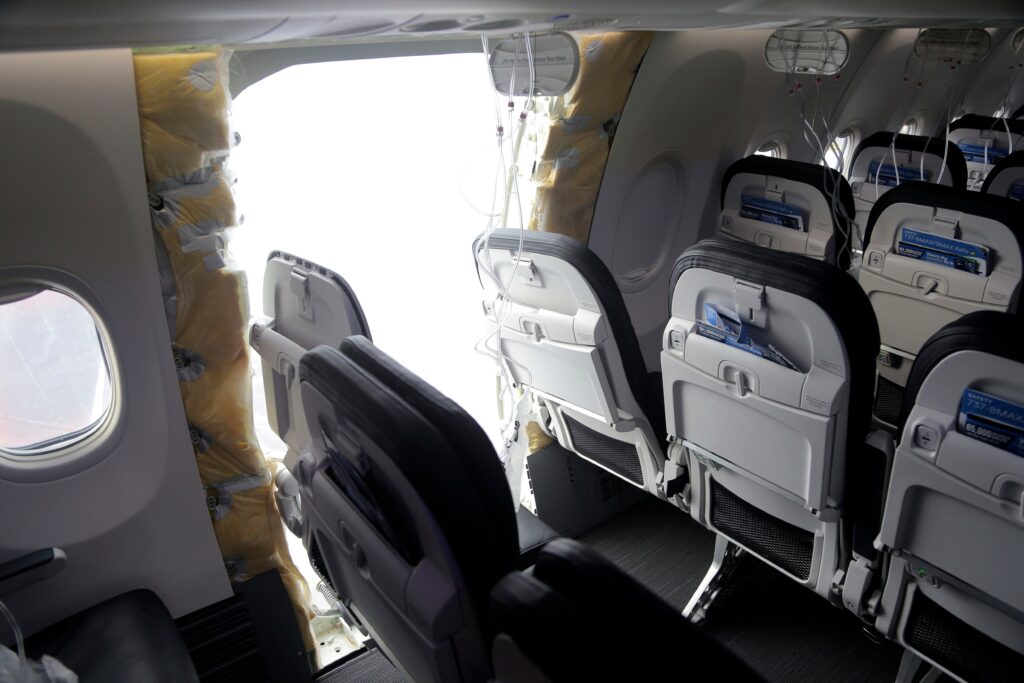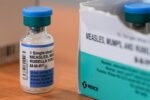The top U.S. aviation investigator officially concluded Tuesday, following a year and a half of investigation, that Boeing and the Federal Aviation Administration, its primary regulator, were responsible for the Alaska Airlines accident.
About fifteen minutes after the Boeing 737 MAX 9 took off from Portland on January 5, 2024, a panel flew off the aircraft. The accident might have easily resulted in passengers being ejected from the plane or maybe brought the aircraft down, yet none of the 177 passengers and crew members on board suffered any significant injuries.
Four fasteners intended to secure the panel were found to be missing early on by National Transportation Safety Board inspectors. The panel gradually slid up and out until it flew off the fuselage because Boeing mechanics in Renton had taken the bolts and panel out for repairs but had neglected to properly replace the hardware.
The NTSB said on Tuesday that Boeing had not given enough supervision, training, or direction to guarantee that manufacturing workers could accurately and consistently follow certain manufacturing procedures.
During a hearing on Tuesday, NTSB Chair Jennifer Homendy stated that an accident such as this does not occur due to a single person or even a group of people. This kind of mishap only occurs when several systems fail at the same time.
The NTSB is entrusted with investigating accidents, identifying what went wrong, and making suggestions to lessen the likelihood that they will occur again. However, it lacks regulatory or enforcement authority.
The FAA and Boeing received 19 recommendations from the NTSB, including the need to reassemble a third-party panel to assess Boeing’s safety culture and implement new methods to monitor noncompliance and record employee training. Among these suggestions are design modifications being made to new aircraft and an order from the FAA to mandate the modifications for the 737 MAX fleet that is currently in operation.
In order to prevent another panel explosion similar to the one that happened on Alaska Airlines Flight 1282, Boeing has finalized design modifications. According to NTSB investigators, the business intends to start producing new 737 MAX aircraft with those modifications in 2026, subject to regulatory approval.
The NTSB also concluded in its investigation that the disaster was caused in part by the FAA’s inadequate compliance enforcement surveillance. Boeing’s repeated and systemic nonconformance issues were not addressed by the FAA.
According to Homendy, the safety flaws that caused this disaster should have been obvious to the FAA and Boeing and could have been avoided.
As we proceed to make changes, Boeing stated that it would examine the final report and suggestions.
A spokesman for Boeing stated, “We at Boeing regret this accident and continue to work on strengthening safety and quality across our operations.”
The FAA stated that it would closely review the safety board’s recommendations, which were released on Tuesday. It also stated that it will continue to monitor Boeing more closely to make sure the business is meeting safety and quality standards.
Since the Alaska Airlines door-plug incident, the FAA has radically altered its oversight of Boeing, and the agency will maintain its strict oversight to make sure Boeing resolves its systematic production-quality problems, the agency stated in a statement.
Design changes
Some aircraft with high-density seating employ a hole in the fuselage as an emergency exit, which is filled by the door plug panel that blew off Alaska Airlines Flight 1282. For those who don’t, Boeing installs a plug that is fastened with four bolts and 12 fittings and stop pads that push together.
NTSB investigators found that the door plug does not require all four bolts to remain in place. Redundancy, a principle of aviation, was incorporated into its design so that in the event that one system, component, or procedure fails, another one takes over.
In this instance, either both upper locking bolts or simply one of the two lower locking bolts would have been sufficient to keep the door plug in place.
A second retention device, fashioned like a hammer and designed to contact with the stop fittings to restrict upward movement, has been developed by Spirit AeroSystems, a supplier to Boeing, since the disaster. To finish the installation, mechanics must rotate the device into place.
Additionally, Boeing equipped the four bolts with lanyards to ensure their permanent attachment and serve as a visual cue that they are in place.
Before Boeing can begin integrating these design modifications into their production line, the FAA must still certify them.
The FAA should issue an airworthiness directive requiring Boeing to equip its current fleet of 737 MAX aircraft with door plugs to include these new design enhancements, according to one of the NTSB’s recommendations.
FAA oversight
The NTSB expressed worries about the effectiveness of Boeing’s regulator’s work, as it has done in the past.
The safety board’s examination revealed that the FAA failed to maintain a systematic record of noncompliance issues, or instances in which Boeing did not adhere to design or regulatory requirements. The NTSB concluded that the FAA rarely took those reoccurring problems into consideration when creating a quality plan for Boeing each fiscal year since it lacked a mechanism for monitoring those shortcomings over time.
These issues have already been raised, such as in an inspector general report from the Department of Transportation in October that concluded the FAA had not gone far enough in identifying and addressing risk in Boeing’s plants.
According to the NTSB, the FAA has expanded the number of inspectors at Boeing factories since the disaster and increased the frequency of surprise audits, which will provide regulators a better idea of how operations typically operate at the factory.
The FAA announced on Tuesday that it meets with Boeing once a week to discuss its progress and any issues it may be having.
Although it acknowledged that Boeing is making strides, it reaffirmed that it would not increase the monthly production cap for 737s at the Renton facility until it was certain the business could continue to produce more aircraft while maintaining safety and quality.
In May, Boeing achieved the milestone of 38 aircraft each month. According to CEO Kelly Ortberg, Boeing will not request that the FAA remove that cap until it has demonstrated that it is still hitting the KPIs it created to track quality and safety. Nevertheless, Ortberg wants to initiate that discussion this year.
Outside the factory
The NTSB found further flaws and safety suggestions in its final report that go beyond Boeing’s manufacturing facilities.
In order to help accident investigators understand what was going on inside during a crisis, it urged aircraft operators to install a 25-hour cockpit voice recorder. This would allow the audio to be preserved inside the cockpit for a longer amount of time. Under the 2024 FAA Reauthorization Act, the rule is currently in effect for new aircraft; however, NTSB members requested that airlines voluntarily update their current fleet.
Additionally, it identified a lack of instruction for flight attendants on the use of portable oxygen bottles and other oxygen equipment. One flight attendant on Flight 1282 struggled so much with one of those bottles that she had to rip the wrapping off with her ID badge.
The NTSB also noted that the flight crew’s handbook lacked instructions on how to assist unaccompanied youngsters in the event that the cabin depressurized, and it urged the FAA to tighten regulations for newborns sitting in a caregiver’s lap as opposed to strapped into a seat.
A Whac-A-Mole game
NTSB member Todd Inman stated in August 2024, six months after the door plug burst, that it seemed as though the industry was engaged in a game of Whac-A-Mole, with new safety concerns emerging every five to ten years.
Inman claimed he was still feeling that way on Tuesday.
A new software system on Boeing’s 737 MAX was the cause of two plane crashes six years ago that claimed 346 lives. It was supply chain and manufacturing limitations last year. A deadly accident between an Army helicopter and a small aircraft operated by American Airlines contributed to this year’s air traffic control issues.
“We’re talking about something different every year,” Inman stated. How can we arrive at a point where we feel certain that the entire system is functioning to ensure everyone’s safety when flying?
The question was directed at NTSB investigator Sabrina Woods, who was fielding inquiries from members of the NTSB about the investigation and its findings.
In response, Woods expressed what she called an unfashionable viewpoint. Woods stated, “I don’t think you can ever get to zero 100%.” What we have here is inherently dangerous.
The goal instead is to find a way to manage the risk so if something does happen, it doesn t result in tragedy.
We no longer fly wooden biwing aircraft. According to Woods, aircraft have become increasingly complex by nature. There will always be something on the horizon.
The Seattle Times, 2025. Check out SeattleTimes.com. Tribune Content Agency, LLC is the distributor.





More Stories
Boeing gets full blame in door plug blowout, promises major changes in 737 Max
Boeing gets full blame in door plug blowout, promises major changes in 737 Max
Boeing gets full blame in door plug blowout, promises major changes in 737 Max